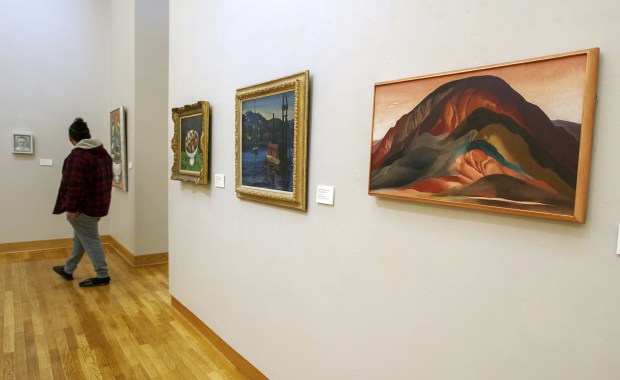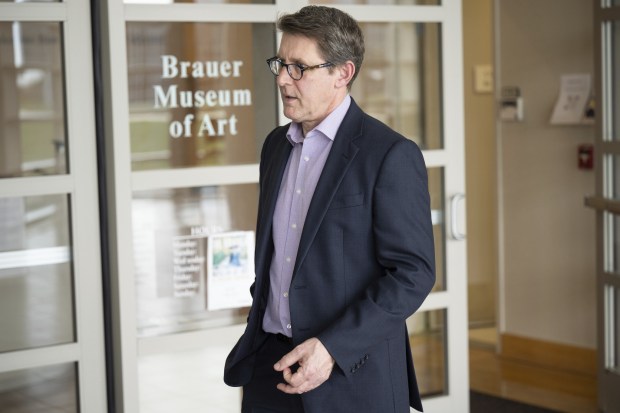The last barrier to Valparaiso University’s plan to auction off three cornerstone pieces of artwork from the Brauer Museum of Art has been removed as Richard Brauer, the museum’s namesake, dropped his bid to intervene in the Porter Superior Court case over whether selling the artwork would violate the trust that paid for it.
Portage attorney Patrick McEuen made the filing on behalf of his client on Wednesday. Brauer cited his work with the museum and allegations in the university’s petition to amend the trust to allow the sale “that Brauer sought and obtained art works not consistent with Percy Sloan’s intent as support for his right to intervene,” according to the filing.
But the university’s attorneys had filed that Brauer’s motion was frivolous since a judge ruled in October that he did not have standing in a lawsuit filed to halt the sale of the paintings, and that the university could seek fees from Brauer if the university was forced to argue on Brauer’s motion to intervene and Brauer was not successful.
“It was a very difficult decision. The University was threatening me, and my attorney, who was representing me pro bono, with sanctions,” said Brauer, the museum’s founding director, in a release provided by McEuen.
“The thought of that fight made me sick to my stomach. A 97-year-old man, and the attorney working for free, facing untold thousands of dollars in sanctions and fines? It was not a position I could afford to be in. I did not want my heir paying fines to Valparaiso University over my decision to try and save the museum which bears my name.”

Andy Lavalley / Post-Tribune
A visitor walks among paintings, including Georgia O’Keeffe’s “Rust Red Hills” (right) at the Brauer Museum of Art on the Valparaiso University campus in Valparaiso, Indiana on Friday, February 10, 2023. (Andy Lavalley for the Post-Tribune)
At this point, nothing stands in the way of Magistrate Ana Osan ruling in the university’s favor, McEuen said in a Friday phone interview.
“This was the Hail Mary, and they never told us how much they were going to ask for in fees,” McEuen said, adding the university had threatened to recoup fees from the lawsuit Brauer filed in October as well.
The only glimmer of hope, McEuen said, is that the magistrate has a contrary opinion from an art scholar, Wendy Greenhouse, who filed with the court on Brauer’s behalf.
“It’s in the judge’s hands now and she can do as she wishes, including granting the petition,” McEuen said. “We anticipate there will be an order granting the petition.”
McEuen said he could not in good conscience counsel Brauer to persist, given the potential for crippling financial sanctions against his client.
“Hopefully the university sets a reserve bid on each piece, because interest in art with such a toxic historical record may disappoint,” McEuen said.
José Padilla, the university’s president, first announced the possible sale of the artwork in February 2023, with plans to use the proceeds from the sale of Georgia O’Keeffe’s “Rust Red Hills,” Frederic E. Church’s “Mountain Landscape” and “The Silver Vale and the Golden Gate” by Childe Hassam, to fund dorm renovations for first-year students.
The news prompted backlash from students, faculty and the art community, and Brauer threatened to remove his name from the museum he founded if the university went ahead with the sale. That, McEuen said by phone, is still likely to occur.
According to appraisals received by the university, the fair market value of the O’Keeffe, is estimated at $10.5 million to $15 million; the Hassam, between $1 million and $3.5 million; and the Church at $1 million to $3 million.
The university petitioned the court in late May to amend the trust from Percy Sloan that provided the funds for the paintings so they could be auctioned off and the money could be used for the dorm renovations, which would include a gallery of lesser works from Sloan’s collection at the museum.
Under the terms of the trust, proceeds from the sale of any of its artwork could only be reinvested in the museum or used to purchase additional artwork. The university has claimed that the cost of housing the paintings securely was too great to keep them given the school’s financial challenges, thereby laying the groundwork to have the trust amended so the paintings could be sold.
Indiana Attorney General Todd Rokita’s office said in a June court filing that it would not object to the sale, removing yet another barrier to the sale.
The university removed the three paintings in question from the museum in September 2023, citing security concerns, and has claimed in its petition that the O’Keeffe and Hassam paintings don’t fit with the collection as established by Sloan and that Richard Brauer knew as much when he authorized the purchase of the O’Keeffe in 1962. The purchase of the Hassam followed five years later.
Brauer and his supporters, as well as McEuen, have criticized what they say is the university’s attempt to besmirch Brauer’s name and his work for the museum by claiming he violated the tenets of the trust.
“I applied to intervene to identify the inconsistencies and inaccuracies in the University’s petition as it pertained to me, and in the process recover my good name. I will now let the University face the consequences of its efforts,” Brauer said in the release.

Kyle Telechan / Post-Tribune
Brauer Museum of Art director and curator Jonathan Canning speaks about the process of deaccessioning art at the museum on Thursday, April 6, 2023. He lost his job in June and the museum has been closed since then. (Kyle Telechan for the Post-Tribune)
Valparaiso University announced the closure of the Brauer Museum in June when 14 staff members, including museum director Jonathan Canning, lost their jobs. Though students have returned to campus and the academic year is underway, the museum remains closed.
“The University Museum is temporarily closed to all visitors at this time. It will reopen in some capacity during this fall semester once we have established a new staffing structure to facilitate its operation,” university spokesman Michael Fenton said in a Friday email to the Post-Tribune.
alavalley@chicagotribune.com
This post was originally published on this site be sure to check out more of their content





